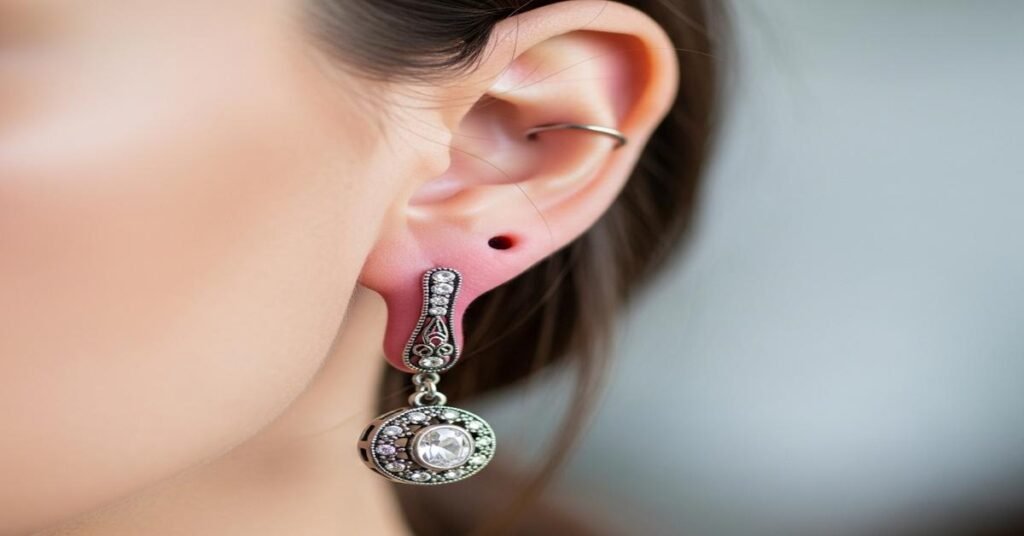Heavy earrings can be stylish. They can also pull on soft tissue for hours a day. That steady traction can thin, stretch, or even split an earlobe. This article explains how much weight is risky, the biological reason earlobes change, how to prevent damage, and realistic ways to fix stretched or split piercings.
How heavy is “heavy”?
There is no single cutoff, but practical thresholds help. Most everyday studs weigh under 1–3 grams per earring. Many fashion drop earrings weigh 5–10 grams. Costume or dense metal designs can be 15–20+ grams.
Rule of thumb:
- Safe for daily wear: under about 3–4 grams per earring for most people.
- Occasional wear: 4–8 grams is usually OK for a few hours, not all day every day.
- High risk: over 8–10 grams per earring when worn frequently. The heavier it is, the faster damage can happen.
These are general numbers. Tissue quality, age, and previous trauma change the limits. Younger skin with good collagen tolerates more force than older, thinner skin.
How heavy earrings damage earlobes (the mechanisms)
Earlobes are mostly fat and connective tissue. They have no cartilage, so they rely on skin strength and collagen. Heavy earrings apply continuous downward force. Over time this causes:
- Mechanical stretch: The piercing hole elongates. The hole becomes a tear or a teardrop shape from repeated pull.
- Tissue thinning: Constant traction reduces local blood flow and collagen integrity, making the lobe thinner and weaker.
- Microtears and scarring: Tiny injuries heal with scar tissue. Scar tissue is less elastic, so future stretching is easier and more permanent.
- Full-thickness split: In advanced cases, the hole can tear entirely, producing a split earlobe that separates into two pieces.
Signs of early and late damage
- Early: earring hangs lower than usual, hole looks oval instead of round, slight redness after long wear, mild soreness.
- Progressive: permanent elongation (you can see extra length when earring removed), recurrent inflammation or tiny crusts at the hole.
- Advanced: visible split through the lobe, inability to sit a stud flat, recurrent infections, keloid or hypertrophic scar formation in susceptible people.
Preventing damage: practical, specific steps
- Limit weight for daily wear. Prefer earrings under 3–4 g for everyday use. Reserve heavier pieces for short events (wear fewer than 4 hours).
- Distribute the load. Use wide disk backs (10–15 mm) or silicone support patches that sit behind the lobe. These spread force across more tissue and reduce point pressure.
- Choose lighter materials. Hollow gold, titanium, gold-filled, or thin wire designs reduce grams without sacrificing look. Compare weight rather than just metal type—solid 14K gold will be heavier than hollow gold or titanium.
- Wear balanced pairs. Avoid one heavy earring on only one side. Single-sided heavy designs concentrate strain on one lobe.
- Use a thicker post. A larger gauge post (e.g., 18g/1.0 mm vs 20g/0.8 mm) spreads the load and resists elongation of the hole. Ask a jeweler for a reinforced post if you like heavier earrings.
- Limit continuous wear. Remove heavy earrings before sleeping, showering, or exercising. Continuous 8–12 hour wear is what causes most gradual damage.
- Care for the skin. Maintain skin health: avoid smoking, use sun protection, and treat local infections promptly. Healthier skin tolerates traction better.
Non-surgical fixes and short-term aids
- Support patches: Silicone or fabric pads stick behind the lobe and reduce pull. They are cheap and useful for special events.
- Fillers: Hyaluronic acid injections can temporarily plump a thin lobe and raise the earring position. This lasts months and can be used while planning definitive repair. It won’t fix a split.
- Change earring type: Switch to studs or small hoops until tissue recovers. Avoid hook or chandelier styles that swing and increase traction.
Surgical repair: what to expect
Yes, heavy earrings can cause permanent damage that needs surgery. The standard repair is an earlobe repair (loboplasty). Key points:
- Procedure: Performed under local anaesthetic. The surgeon excises the stretched or scarred tissue and re-sutures the lobe so the piercing hole is closed and the lobe looks symmetrical.
- Recovery: Stitches removed in 5–7 days. Normal activity in a few days. Full healing 6–8 weeks.
- Costs (US example): typically around $600–$1,500 depending on region and clinic. Cosmetic surgeons and ENT/plastic surgeons perform this work.
- Re-piercing: Often safe after healing. Surgeons usually recommend waiting 3–6 months and repiercing slightly above the repaired area to avoid scar tissue.
- Outcome: Scars are usually thin and well hidden. Repair restores shape and function in most cases.
When to see a doctor
- Visible split in the lobe or the earring falls through the hole.
- Recurrent infection despite basic care (redness, pus, spreading pain).
- Large, painful scar or suspected keloid formation.
- Cosmetic concern about a stretched hole that won’t shrink after stopping heavy earrings for several months.
Bottom line: Heavy earrings can permanently damage earlobes over time. The risk depends on weight (grams), how long you wear them, and your lobe’s tissue quality. Prevent damage by choosing light designs, spreading load with wider backs or support patches, and limiting continuous wear. If you already have severe stretching or a split, surgical repair reliably restores the lobe. For mild thinning, temporary measures like fillers and support pads can help while you plan a permanent fix.
I am G S Sachin, a gemologist with a Diploma in Polished Diamond Grading from KGK Academy, Jaipur. I love writing about jewelry, gems, and diamonds, and I share simple, honest reviews and easy buying tips on JewellersReviews.com to help you choose pieces you’ll love with confidence.

